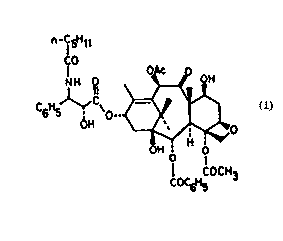Une partie des informations de ce site Web a été fournie par des sources externes. Le gouvernement du Canada n'assume aucune responsabilité concernant la précision, l'actualité ou la fiabilité des informations fournies par les sources externes. Les utilisateurs qui désirent employer cette information devraient consulter directement la source des informations. Le contenu fourni par les sources externes n'est pas assujetti aux exigences sur les langues officielles, la protection des renseignements personnels et l'accessibilité.
L'apparition de différences dans le texte et l'image des Revendications et de l'Abrégé dépend du moment auquel le document est publié. Les textes des Revendications et de l'Abrégé sont affichés :
| (12) Demande de brevet: | (11) CA 2140519 |
|---|---|
| (54) Titre français: | TAXANE POSSEDANT UNE ACTIVITE ANTITUMORALE |
| (54) Titre anglais: | TAXANE HAVING ANTITUMOR ACTIVITY |
| Statut: | Réputée abandonnée et au-delà du délai pour le rétablissement - en attente de la réponse à l’avis de communication rejetée |
| (51) Classification internationale des brevets (CIB): |
|
|---|---|
| (72) Inventeurs : |
|
| (73) Titulaires : |
|
| (71) Demandeurs : |
|
| (74) Agent: | KIRBY EADES GALE BAKER |
| (74) Co-agent: | |
| (45) Délivré: | |
| (86) Date de dépôt PCT: | 1994-05-03 |
| (87) Mise à la disponibilité du public: | 1994-12-08 |
| Requête d'examen: | 2001-04-30 |
| Licence disponible: | S.O. |
| Cédé au domaine public: | S.O. |
| (25) Langue des documents déposés: | Anglais |
| Traité de coopération en matière de brevets (PCT): | Oui |
|---|---|
| (86) Numéro de la demande PCT: | PCT/EP1994/001405 |
| (87) Numéro de publication internationale PCT: | EP1994001405 |
| (85) Entrée nationale: | 1995-01-18 |
| (30) Données de priorité de la demande: | ||||||
|---|---|---|---|---|---|---|
|
La présente invention concerne une nouvelle taxane possédant la structure (1) qui est isolée de l'écorce des racines des plantes de l'espèce Taxus. Le composé (1) est pourvu d'une activité anti-tumeur plus importante que celle du taxol, car il est actif, contrairement à ce dernier, contre les cellules résistant à l'adriamicyne et comme agent antileucémique.
The present invention relates to a new taxane having
the structure (1), which is isolatable from root bark of plants
of the Taxus genus. The compound (1) is endowed with
antitumor activity higher than the one of taxol, the former
being active, unlike hte latter, also against adriamicine
resistant cells and as antileukemic drug.
Note : Les revendications sont présentées dans la langue officielle dans laquelle elles ont été soumises.
Note : Les descriptions sont présentées dans la langue officielle dans laquelle elles ont été soumises.

2024-08-01 : Dans le cadre de la transition vers les Brevets de nouvelle génération (BNG), la base de données sur les brevets canadiens (BDBC) contient désormais un Historique d'événement plus détaillé, qui reproduit le Journal des événements de notre nouvelle solution interne.
Veuillez noter que les événements débutant par « Inactive : » se réfèrent à des événements qui ne sont plus utilisés dans notre nouvelle solution interne.
Pour une meilleure compréhension de l'état de la demande ou brevet qui figure sur cette page, la rubrique Mise en garde , et les descriptions de Brevet , Historique d'événement , Taxes périodiques et Historique des paiements devraient être consultées.
| Description | Date |
|---|---|
| Demande non rétablie avant l'échéance | 2004-05-03 |
| Le délai pour l'annulation est expiré | 2004-05-03 |
| Réputée abandonnée - omission de répondre à un avis sur les taxes pour le maintien en état | 2003-05-05 |
| Inactive : Dem. traitée sur TS dès date d'ent. journal | 2001-05-17 |
| Inactive : Renseign. sur l'état - Complets dès date d'ent. journ. | 2001-05-17 |
| Lettre envoyée | 2001-05-17 |
| Toutes les exigences pour l'examen - jugée conforme | 2001-04-30 |
| Modification reçue - modification volontaire | 2001-04-30 |
| Exigences pour une requête d'examen - jugée conforme | 2001-04-30 |
| Inactive : Demande ad hoc documentée | 1997-05-05 |
| Réputée abandonnée - omission de répondre à un avis sur les taxes pour le maintien en état | 1997-05-05 |
| Demande publiée (accessible au public) | 1994-12-08 |
| Date d'abandonnement | Raison | Date de rétablissement |
|---|---|---|
| 2003-05-05 | ||
| 1997-05-05 |
Le dernier paiement a été reçu le 2002-04-22
Avis : Si le paiement en totalité n'a pas été reçu au plus tard à la date indiquée, une taxe supplémentaire peut être imposée, soit une des taxes suivantes :
Les taxes sur les brevets sont ajustées au 1er janvier de chaque année. Les montants ci-dessus sont les montants actuels s'ils sont reçus au plus tard le 31 décembre de l'année en cours.
Veuillez vous référer à la page web des
taxes sur les brevets
de l'OPIC pour voir tous les montants actuels des taxes.
| Type de taxes | Anniversaire | Échéance | Date payée |
|---|---|---|---|
| TM (demande, 4e anniv.) - générale | 04 | 1998-05-04 | 1998-04-15 |
| TM (demande, 5e anniv.) - générale | 05 | 1999-05-03 | 1999-04-27 |
| TM (demande, 6e anniv.) - générale | 06 | 2000-05-03 | 2000-04-17 |
| TM (demande, 7e anniv.) - générale | 07 | 2001-05-03 | 2001-04-27 |
| Requête d'examen - générale | 2001-04-30 | ||
| TM (demande, 8e anniv.) - générale | 08 | 2002-05-03 | 2002-04-22 |
Les titulaires actuels et antérieures au dossier sont affichés en ordre alphabétique.
| Titulaires actuels au dossier |
|---|
| INDENA S.P.A. |
| Titulaires antérieures au dossier |
|---|
| BRUNO GABETTA |
| EZIO BOMBARDELLI |